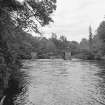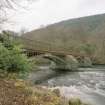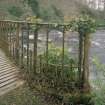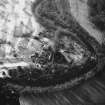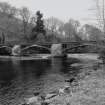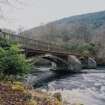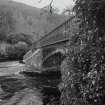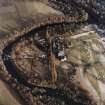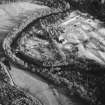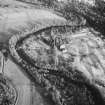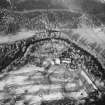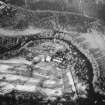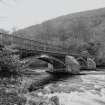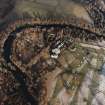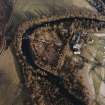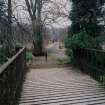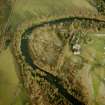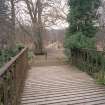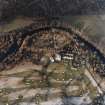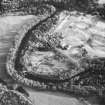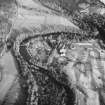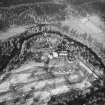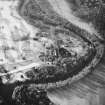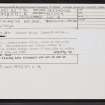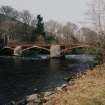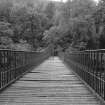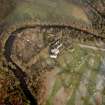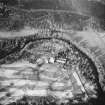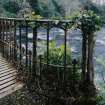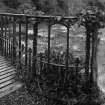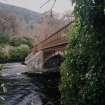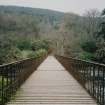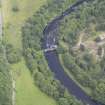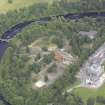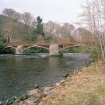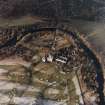Taymouth Castle, Chinese Bridge
Ornamental Bridge (19th Century)
Site Name Taymouth Castle, Chinese Bridge
Classification Ornamental Bridge (19th Century)
Alternative Name(s) Taymouth Castle Policies; Taymouth Castle, Estate Footbridge; River Tay
Canmore ID 24949
Site Number NN74NE 14.02
NGR NN 78243 46734
Datum OSGB36 - NGR
Permalink http://canmore.org.uk/site/24949
- Council Perth And Kinross
- Parish Kenmore (Perth And Kinross)
- Former Region Tayside
- Former District Perth And Kinross
- Former County Perthshire
NN74NE 14.02 78243 46734
NN 7825 4671. Chinese Bridge, Taymouth Castle. This is a three-arched bridge, built in the early 19th century. The cutwaters are perhaps relics of a previous wooden bridge, shown at this site in estate maps of 1754 and 1786.
HBD List.
Visited and photographed by J R Hume, University of Strathclyde, 7 June 1976.
NMRS, MS/749/95.
(Location cited as NN 782 468). Chinese Bridge, Taymouth Castle. Built with wooden spans before 1754 and rebuilt early 19th century. A three-span, cast-iron arch bridge with two-rib Tudor arches, Gothic cast-iron railings and wooden deck. The piers and abutments are of rubble construction. Disused and decaying.
J R Hume 1977.
Bridge falling into disrepair and not in use at present.
Visited by OS (BS) 29 November 1978.
This bridge carries an estate footpath over the River Tay to the N of Taymouth Castle (NN74NE 14.00). It is depicted, but not noted, on the 1982 edition of the OS 1:10,000 map.
The location assigned to this record defines the midpoint of the structure. The available map evidence (current GIS AIB) indicates that it extends from NN 78224 46752 to NN 78261 46716.
Information from RCAHMS (RJCM), 5 March 1998.
3-arch bridge, Tudor cast iron bridge over the river Tay leading north from the rear of Taymouth Castle. One of the spectacular and complete group of structures making up the Taymouth Castle estate. (Historic Scotland) Possibly inherited its name from its timber predecessor (N.Haynes) .
The castle and its contents were sold in 1922 and it became a hotel. The site operated as a Polish hospital during the war and was later leased to a civil defence school.
Publication Account (1987)
The Chinese Bridge was built by the 3rd Earl of Breadalbane in the mid 18th century as a private estate bridge to allow pedestrians, riders and light carriages to cross the River Tay without requiring to leave the park surrounding Taymouth Castle. It derives its name from supposed eastern qualities in the design, yet its general appearance and proportion owe more to the arches and window tracery of Tudor Gothic than to eastern bridge construction.
The elegant cast-iron structure comprises three equal spans supported at each bank by stone abutments and in the river by two stone piers carefully designed to provide a cut -water whilst echoing the curves of the ironwork. The carriageway is only 2.7m wide and is enclosed by elegant railings. In the description of Queen Victoria's visit to Taymouth Castle in 1842, there is an account of a drive taken by the Royal party via the Chinese Bridge and a more utilitarian wrought iron structure, known as Newhall Bridge (NN 789469), situated about 1.2km downstream.
Both bridges are now closed to traffic but a footbridge has been constructed within the original framework of Newhall Bridge for the convenience of anglers.
Information from ‘Exploring Scotland’s Heritage: Fife and Tayside’, (1987).
Project (2007)
This project was undertaken to input site information listed in 'Civil engineering heritage: Scotland - Lowlands and Borders' by R Paxton and J Shipway, 2007.
Publication Account (2007)
Taymouth Castle dates from 1801–42 and was the home of the Marquis of Breadalbane, where Queen Victoria was received with much splendour in 1842. By this time the present cast-iron bridge over the Tay, supported from the stone piers of a ‘Chinese’ style hump-backed timber bridge of the third quarter of the 18th century, almost certainly existed as an enhancement to the castle grounds, which now form part of a golf course.
It is an elegant 9 ft wide bridge of three arches in the Tudor–Gothic style carrying a timber deck. The arches
span 45 ft between the earlier masonry piers 9 ft wide and have a rise of about 6 ft. They are pointed at the crown and sharply curved at the haunches, the section between these points being very nearly straight.
The cast-iron ribs have flat plate cross-sections and a minimum of diagonal angle-bracing near the haunches.
The spandrels are filled with slender cast-iron ornamental panels, some cracked. The parapet railings, about 4 ft high, are of similar design. This design, seen also in thewindows and masonry of the nearby castle, suggests that the designer of the bridge may have been Gillespie Graham the architect for the 1838–42 extension and embellishments to the castle in the run up to the royal visit.
R Paxton and J Shipway
Reproduced from 'Civil Engineering heritage: Scotland - Lowlands and Borders' with kind permission of Thomas Telford Publishers.


















































